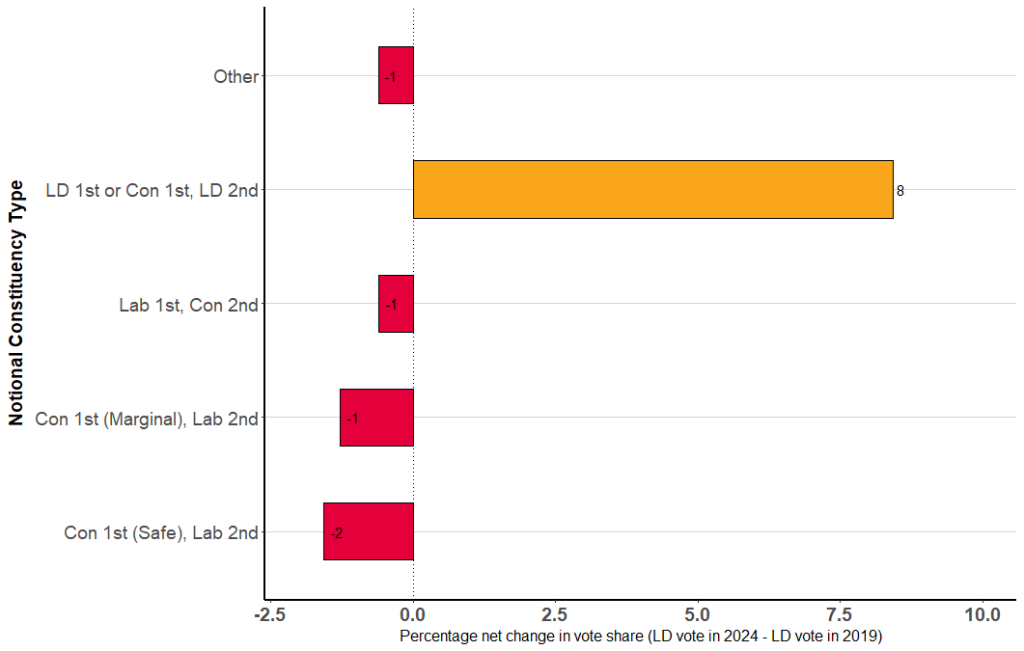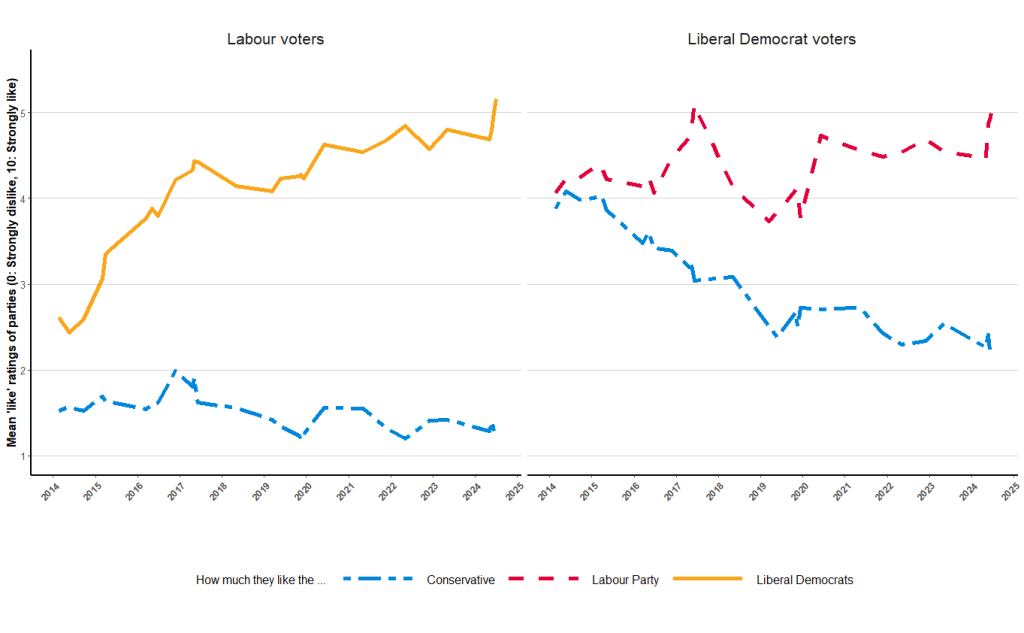James David Griffiths, Jane Green, Ed Fieldhouse
Ahead of the release of the pre/post-election waves of the British Election Study Internet Panel, members of the team explore how we can use it to help us understand the 2024 UK General Election – starting with the performance of the Liberal Democrats.
The Liberal Democrats headed into the 2024 UK General Election full of confidence. After their excellent performance in the local elections, Ed Davey claimed that the Conservatives would be “looking over their shoulder” before the general election. This prediction was on the mark, as the Liberal Democrats won 72 seats – 64 more than they managed in 2019. Understanding how they managed this feat is important because these Liberal Democrat victories served to increase the scale of the Conservatives’ defeat. Therefore, in this first examination of 2024 Liberal Democrat support, I discuss two contributing factors – the efficiency of their vote and tactical voting.
The first step in understanding the Liberal Democrats’ performance in 2024 is to examine the efficiency of their vote. We can describe a party as being ‘efficient’ if they concentrate their vote in the areas where they can win, and do not ‘waste’ votes in areas where they are not competitive. Overall, this was true for the Liberal Democrats in 2024, whose vote went up in the places where they were the major challenger to the Conservatives (Figure 1) – i.e., in (notional) 2019 constituencies where they either finished first or were second to the Conservatives. In contrast, the Liberal Democrats’ support went down (slightly) in the areas where they were not in direct competition with the Conservatives. Ultimately, it was this greater concentration of the Liberal Democrats’ vote that helped them to win so many more seats, despite their vote share being very similar to 2019 (rising from 11.6 to 12.2 percent).
Figure 1: Change in the Liberal Democrat’s vote share (2019-2024) in England and Wales
Source of the results – House of Commons Library Results Files for 2019 and 2024. Estimates for the notional constituencies compiled by Professors Colin Rallings and Michael Thrasher, Associate Members of Nuffield College, Oxford and Emeritus Professors at the University of Plymouth on behalf of BBC News, ITV News, Sky News and the Press Association
Tactical voting among Labour supporters was one of the key reasons for this more efficient Liberal Democrat vote. We can see this by examining data from the soon-to-be released post-election wave of the British Election Study Internet Panel (Figure 2). Here, we can see how the Liberal Democrats gained support in areas where they were the main competition to the Conservatives, as 44 percent of 2019 Labour voters switched to them in these areas. This stands in stark contrast to the other seat types, where the Liberal Democrats were less likely to defeat the Conservatives and thus gained far fewer 2019 Labour voters. Instead, a much higher proportion of 2019 Liberal Democrat voters switched to Labour in 2024. In this sense, there are considerable parallels here to 1997, when the Liberal Democrats won seats from an unpopular Conservative government with the help of tactical Labour voters.
Figure 2: Proportional switching between Labour and Liberal Democrats by (notional) constituency types (2019-2024) in England and Wales
Source: British Election Study Internet Panel (W19-W29). Switching defined as people who voted for one party in 2019 and then voted for the other in 2024.
Yet, 2024 is different to 1997 because – this time – the Liberal Democrat supporters have become less supportive of the Conservatives – rather than more supportive of Labour (Figure 3). The growing distaste for the Conservatives among the Liberal Democrats began around the end of the coalition government in 2015, and it continued at pace throughout the Brexit negotiation period when the Liberal Democrats opposed the Conservatives’ pro-Brexit stance. Simultaneously, Labour supporters have become increasingly more positive about the Liberal Democrats over the last decade. These changing perspectives towards the major parties no doubt fuelled this anti-Conservative tactical voting in 2024, as people are more willing to vote tactically when they strongly dislike one party, and are indifferent towards to others.
Figure 3: Mean scores on a like/dislike scale for Conservative, Labour, and Liberal Democrat supporters
Source: British Election Study Internet Panel. 0: Strongly dislike, 10: Strongly like. I use Labour/Liberal Democrat vote intention in each available wave of the panel, to capture the assessments of those who would vote for each party at each given moment of measurement.
Overall, this first examination of the Liberal Democrats’ performance in 2024 demonstrates (again) that we need to understand their success in the light of the relative (un)popularity of the other major parties. By positioning themselves clearly as an anti-Conservative option in many seats, the Liberal Democrats were able to convince many Labour supporters to lend them their vote in places where they could challenge the incumbent government (as they did in 1997). Such tactical voting helped the Liberal Democrats to win so many seats in 2024, but it still means that their electoral position is somewhat precarious. If the Conservatives become less unpopular, or the desire to keep them out of power becomes less compelling, then the Liberal Democrats may not be able to rely on Labour voters backing them in their newly won seats. Consequently, the challenge for Ed Davey now is how to convert these short-term victories into longer term bases of Liberal Democrat support.




